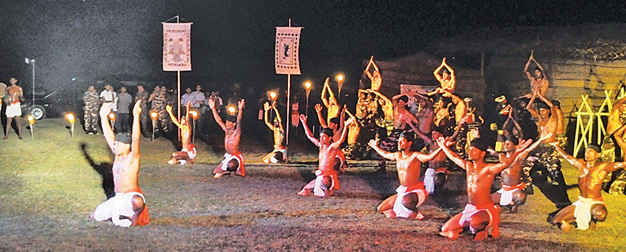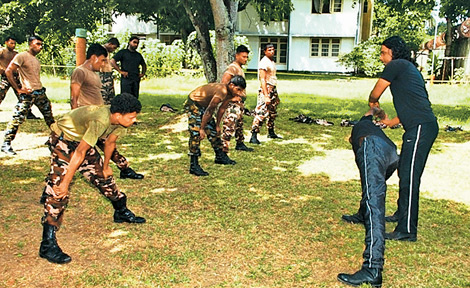|
A combat exercise without weapons:
Angampora training to power SLAF
By Dhaneshi Yatawara
Flying has become a common transport mode in today's world unlike the
bygone days where it was a luxury. Being a speedy transport mode to suit
various demands flying carries its own risks as well - especially by
threats posed by many scary factors that exist such as terrorism and
crime. Events during the recent past such as plane hijacks and mid-air
explosions have dented the attractions of flying. Against such a
backdrop security and safety have become crucial factors.
|

Ajantha Mahantharachchi |
Though we have only one national carrier for air transport there are
a number of domestically operating flights mainly serving the high end
market in tourism. As the institute background of these carrier airlines
is an assurance on safety the commercial wing of the Sri Lanka Air Force
passenger transportation, Helitours, is highly recognised considering
its safety and security. Unlike in military, in commercial passenger
transportation the staff cannot carry weapons under any circumstances.
This was a challenge to the Sri Lanka Air Force as tightening
security means rigorous check-ups on passengers which will not be
pleasant for their customer service.
Solution
Yet, today the Air Force has found an indigenous solution to ensure
security for passengers. It is an unarmed defence technique that
developed over centuries on our own soil.
It is a highly disciplined self-defence technique, and also a sport
for any adventurous human being. It is not only an exercise but a
meditation, our own home grown body combat which is famously known as
Angampora. Staying isolated only among the professionals for centuries
due to banning in Colonial era, Angampora has started its campaign to
strengthen the defenders of the country.
Angampora is mostly a combat exercise without weapons. To strengthen
the defence capabilities of staff involved in air transport and office
work, Angampora was a very useful tool. Airline crews of the Air Force,
specially engaged in civilian transportation cannot carry weapons on the
deck. Thus the only option available to protect the passengers in an
emergency is body combat. And Angampora would be the ideal option for
such an event.
Thus the Air Force also targeted training office staff as well as
their airline crew to manage and thwart criminal efforts using the
defence techniques of Angampora.
Angampora is a unique technique that uses not only weapons but also
hand to hand fight, an ideal method to make a perfect soldier - creating
a true hero rather than a fake celluloid one. Combat techniques wherein
weapons are used are called Illangam. Maya Angam is a technique which
involves the use of spells and use pressure points in the body to
confuse or bring an opponent down. Understanding the value of the
indigenous traditions Sri Lanka Air Force took in the Angampora
techniques in to their style.
SLAF initiative
"Apart from the Airline crews this was helpful to Air Force staff
deployed in remote areas of the country for added protection to their
camps," said Group Captain Camillus Labrooy who is in charge of the Air
Force Angampora training pool. The Air Force initiative was for the Air
Force Regimental Special Force at the beginning. Training started in
2012 and today they are continuing with the second batch. In 2013 the
Air Force started a special Angampora training for the children of the
Air Force personnel. Training sessions for children studying from year
six to A/L classes are held at the BMICH.
|

Training sessions in progress |
"There was a good response from the Air Force personnel to this. A
lot of parents started sending their children," said Group Captain
Camillus Labrooy.
The Air Force has introduced key aspects of Angampora to school
cadets. "We try to inculcate the discipline and habits for a healthy
lifestyle by introducing certain elements of Angampora," said Group
Captain Labrooy. "We held a special camp for Diyathalawa recently and we
hope to continue with it to improve the character of the school cadets
as well as their health," he said.
Ajantha Mahantharachchi who is also the 'Angam Muhandiram' is the
leader of this training pool. According to traditions the leader of the
entire clan of Angampora professionals is called the 'Angampora
Muhandiram'. During the time of kings he was the leader for all the
Angampora professionals of the entire country. Since then there have
been a few families involved in Angampora .
Ajantha Mahantharachchi belongs to the Korathota generation. But now
we select an 'Angam Muhandiram' within the 'Angam Maduwa' - the hall
where the wrestlers get together to train and practise. 'Panikkiralas'
are the trainers who teach the wrestlers.
Tradition
The opportunity to study the indigenous combating technique is rare
and those accepted into the circle are chosen with utmost care. Angam
Muhandiram Ajantha Mahantharachchi said that he depended on the
instructions written in ola leaves. "Not everyone can become a student
of Angampora.
"The horoscope must be read. It carries weight and tells us what the
past life experiences of any person. "We need to know what the person's
life expectancy is and if he possesses the qualities of a warrior.
Purity of thought and the potential to develop one's mind is
comprehensible through the message of the ola leaf. We need to know if
their knowledge of the Angam Satan Kalawa (the fighting techniques of
Angam) will not lead them to take advantage of others or use it
unjustly," Mahantharachchi said.
|

Training sessions in progress |
The techniques of combat depend heavily upon psychological
development, physical exercise, healthy eating and Ayurvedic healing.
When we are giving training in general we cannot do that in full as
it is not the tradition of Angampora, said Mahanthaarachchi.
Today traditional Angampora is taught at the Korathota Angampora
maduwa, which is made like an old fashioned mud and clay theatre.
For the school cadets the meditation, yoga and general self-defence
techniques are taught.
According to Mahanthaarachchi, there are meditation and yoga
techniques unique to 'Angampora' training. "Meditation does improve
concentration and memorising capacities and as professionals we have
well experienced it," he said.
The yoga techniques are specific to Angampora. "It is totally
different from the Indian yoga.
Angampora tradition itself proves that Sri Lankans had unique habits
and practices supporting a healthy life style. The yoga technique is a
good example," he said. |

